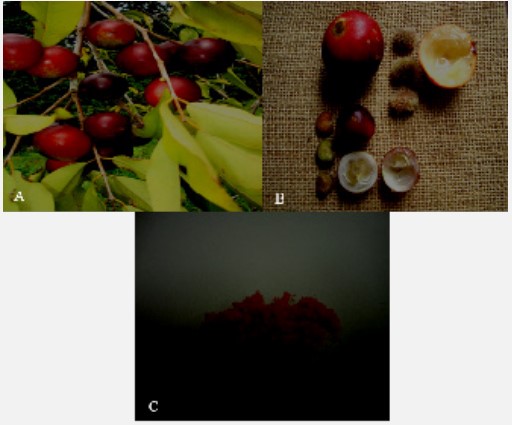Short Commentary
Volume 2, Issue 4
Bioactive Compounds of Exotic Tropical Camu-Camu (Myrciaria Dubia) in the Seed, Ripe Fruit and Freeze-Dried
Jeff Moats2; Jaime Paiva Lopes Aguiar1*; Francisca das Chagas do Amaral Souza1
1Brazilian National Institute for Research in the Amazon, Laboratory of Physical Chemistry of Food (LFQA), Manaus, AM, Brazil.
2Origens Amazônia, LLC, Naples, Flórida, EUA.
Corresponding Author :
Jaime Paiva Lopes Aguiar
Email: jaguiar@inpa.gov.br
Received : Mar 31, 2023 Accepted : Apr 18, 2023 Published : Apr 25, 2023 Archived : www.meddiscoveries.org
Citation: Moats J, Lopes Aguiar JP, Amaral Souza FC. Bioactive Compounds of Exotic Tropical Camu-Camu (Myrciaria Dubia) in the Seed, Ripe Fruit and Freeze-Dried. Med Discoveries. 2023; 2(4): 1035.
Copyright: ©2023 Lopes Aguiar JP. This is an open access article distributed under the Creative Commons Attribution License, which permits unrestricted use, distribution, and reproduction in any medium, provided the original work is properly cited.
Introduction
Camu-camu (Myrciaria dubia) fruits are promising sources of various bioactive compounds such as vitamin C, phenolic compounds and carotenoids. Camu-camu is a fruit native to the Amazon region and is considered the greatest natural source of vitamin C worldwide are also good sources of dietary fiber, minerals, polyphenols and antioxidants. Therefore, the objective of this study is to provide existing information of the chemical composition and phytochemicals in promoting health, especially vitamin C, polyphenols in the camu-camu seed , camucamu ripe and whole camu-camu fruit powder (Figure 1).
The study camu-camu was collected AGROPECUÁRIA JAYORO LTDA manually during the ripening stage in Presidente Figueiredo, AM with the following geographic coordinates: 2º 2’ 4’’ S to 60º 1’ 33’’ W. Camu-Camu samples were homogenized in a blender before the physical and chemical analyses , to quantify fiber, polyphenols, minerals, some vitamins, and antioxidants. Fiber contents were determined by the method proposed by [1]. Vitamin C content was extracted and measured in triplicate by High-Performance Liquid Chromatography (HPLC) following the method proposed by AOAC, 2016. Twenty grams of homogenate was mechanically stirred in 60 ml of a 5% (w/v) solution of metaphosphoric acid for 15 min. The mixture was filtered ( Whatman nº 541), and the was diluted to 100 ml with HPLC grade water. An aliquot of the acid extract was then filtered through 0.45 µm Millipore filter prior to injection into the chromatographic column. The HPLC apparatus used consisted of a Spectra-Physics liquid chromatograph equipped with an SP 8800 ternary pump and a Rheodyne 20 µL in jection loop and a Spectra Focus UV Vis forward optical scanning detector controlled by Spectra Focus software. The column was a Tracer ODS2 C18 Column (4 id x 250 mm) of particle size 5 µm (Tecknocromc TR-015326) packed with the same material. The mobile phase was HPLC grade water brought to pH 2.2 with metaphosphoric acid, the flow rate was 0.5 ml.min-1, the detection wavelength was 245 nm. Quantitation used the external standard method. This method was developed in our laboratory and it is described in detail in a previous paper Association of Official Agricultural Chemists (2016) [2].
Minerals contents were determined by digesting the sample (CEM Coorporation, model MD-2591) and reading the solution with an atomic absorption spectrometer. Antioxidant capacity was determined as recommended by [3] using 2,2-dyphenylpicrylhydrazil (DPPH). The absorbance was read three times at 515 nm, and the antioxidant capacity was calculated as μmol of Trolox equivalents (TE) per gram.
The contents antioxidant capacity in camu camu fruit present as extremely high in freeze-dried camu-camu 52,000 μmol TE/g, much higher than ripe camu-camu pulp 3486 μmol TE/g and seed 893 μmol TE/g fresh weight. Camu-camu fruits are considered the richest natural source of vitamin C in Brazil (Justi et al., 2000). Shows that freeze-dried has a high concentration of vitamin C, approximately 20.31 g/100 g, naturally much higher than that in fresh pulp 2840 mg/100 g and seed 480 mg/100 g. Vitamin C content in camu-camu was also higher than in other Brazilian fruits, such as acerola (1357 mg/100 g of fresh fruit) and acai (84 mg/100 g of fresh fruit). These results demonstrated that the vitamin C-rich fraction was the major contributor to the total antioxidant capacity of camu-camu fruit despite the high losses incurred. Camu-camu is also an excellent source of other bioactive compounds, such as minerals as sodium, potassium, calcium, zinc, magnesium, manganese and dietary fiber and different phenolic compounds. Further studies are necessary to elucidate the overall potential of this fruit.
Table 1: Nutritional composition of camu-camu.
| Camu-Camu (Fresh Weight) | Ripe | Freeze-dried | Seed |
|---|---|---|---|
| Carbohydrates (g/100g) | 5.9 | 47 | 2,2 |
| Ash (g/100g) | 0.213 | 3.67 | 0,1 |
| Moisture (g/100g) | 92.8 | 5.9 | 32.5 |
| Fiber (g/100g) | 1.69 | 19.23 | 15.74 |
| Ferro (mg/100g) | 0.232 | 2.23 | 0.18 |
| Sodium (mg/100g) | 2.49 | 0.2 | 0.1 |
| Calcium (mg/100g) | 8.64 | 22.12 | 0.18 |
| Protein (g/100g) | 0.99 | 6.63 | 0.5 |
| Vitamin C (mg/100g) | 2840 | 20310 | 480 |
| Antioxidant Capacity (umol TE/g) | 3486 | 52 | 896 |
Conclusions
Camu-camu fruits is also an excellent source of other bioactive compounds, such as minerals, vitamin C and antioxidant capacity. In conclusion, camu-camu fruits can be used in food products and to delay or prevent many human diseases.
Acknowledgements: We thank BFN/FAO (Biodiversity for Food and Nutrition) and INPA (National Research Institute of Amazonia), Origens Amazônia, LLC, AGROPECUÁRIA JAYORO LTDA and FAPEAM processes 062.00682/2015 and 062.00796/2015, for their financial support.
References
- Asp NG, Johansson CG, Hallmer H, Siljestroem M, et al. Rapid enzymatic assay of insoluble and soluble dietary fiber. J Agric Fd Chem. 1983; 31: 476-482.
- Association of Official Agricultural Chemists – AOAC. Offícial Methods of the Association of the Agricultural Chemists: AOAC: Washington, DC, USA. 2016.
- Brand-Williams W, Cuvelier ME, Berset CLWT. Use of a Free Radical Method to Evaluate Antioxidant Activity. Technol. 1995; 28: 25-30.



